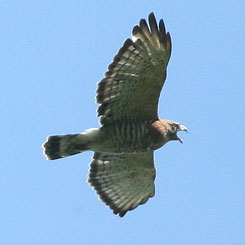The broad-winged hawk flies thousands of miles to its winter grounds in South America each year. The trip is long and takes a lot of energy. If they had to flap their wings and fly that distance, they would need to stop frequently to rest and eat to keep up their energy and the trip would take a lot longer. What to do? The broad-winged hawk uses the thermals to make their trip easier!
Thermals are columns of rising air that form when the sun warms the earth. The warmed earth then warms the air directly above it. The warmed air is not as dense as the cooler air around it so it rises. As the air rises, it cools.
 The air stops rising once it has cooled to the same temperature as the air around it. Thermal columns of hot air can rise as high as a mile. The rising air is strong enough to lift all kinds of things like dust, water vapor, and broad-winged hawks. Thermals frequently form above mountains because the sun heats mountainsides unevenly! You often see cumulus clouds above thermals. As the air in a thermal cools, the water vapor in it condenses and forms the cumulus clouds. The air stops rising once it has cooled to the same temperature as the air around it. Thermal columns of hot air can rise as high as a mile. The rising air is strong enough to lift all kinds of things like dust, water vapor, and broad-winged hawks. Thermals frequently form above mountains because the sun heats mountainsides unevenly! You often see cumulus clouds above thermals. As the air in a thermal cools, the water vapor in it condenses and forms the cumulus clouds.
A hawk will circle up with its wings extended and ride a thermal until the thermal loses its lift. The hawk then peels off from the thermal and glides on to the next thermal and the next one and the next one and so on, as it works its way south to its winter grounds.
Normally, broad-winged hawks are solitary birds, but they migrate in groups called kettles. They may form kettles because they are all riding the same thermals south! Kettles can contain up to a 1,000 hawks!
|

